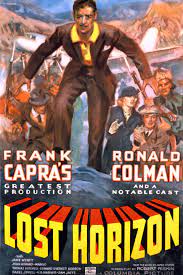
In 1935 war has broken out in the city of Baskul, China. Ninety Westerners are still in the city and will be slaughtered if they aren’t evacuated. Foreign Secretary Robert Conway (Ronald Colman) is responsible for making sure they are all flown out. Planes continue to fly in and pick up passengers. The only ones left are Conway along with his brother George (John Howard) and three other people, a British citizen named Lovett (Edward Everett Horton), Barnard (Thomas Mitchell) and Gloria (Isabel Jewell). They board the last plane and head out into the night just before the revolutionaries attack the airport.
All that night the five passengers sleep believing they are headed east toward Shanghai. In the morning they realize they are actually heading west toward Tibet. The pilot was removed before they took off and the plane was hijacked. They eventually set down in a small village where the villagers refuel the plane. They take off again and continue west until the plane runs out of fuel and crashes. The passengers are rescued by Chang (H.B. Warner) and a group of Tibetans. The rescued party is taken to a Lamasery in a green sheltered valley. The valley is called Shangri-La.
Eventually the five newcomers become enchanted with Shangri-La and find themselves wanting to stay. Everyone except George. George is frustrated and angry at being stuck in Shangri-La and is determined to leave. Robert is especially happy since meeting Sondra (Jane Wyatt). He is also fascinated with the ancient High Lama (Sam Jaffe). The High Lama turns out to be the man that created the idyllic Lamasery two hundred years ago and had arranged for Robert to be brought to Shangri-La to take over for the Lama who is now dying. But Robert’s selfishness threatens everything that Robert has come to love.
“Lost Horizon” was released in 1937 and was directed by Frank Capra. It is an adventure drama and a fantasy and was based on the novel by James Hilton. In 2016, the film was selected for preservation in the United States National Film Registry by the Library of Congress as being "culturally, historically, or aesthetically significant".
Originally 132 minutes long, the film was whittled down to as much as 92 minutes long. In 1973, the American Film Institute initiated a restoration of the film. The project was undertaken by the UCLA Film and Television Archive and Columbia Pictures. It took 13 years to complete the restoration. The entire 132 minutes of the original soundtrack was recovered but, ultimately, only 125 minutes of film could be found. The missing seven minutes of film footage was replaced with photos of the actors in costume taken during filming and still frames depicting the missing scenes.
Capra made a lot of movies that featured an average guy who overcame adversity. He showcased American idealism in his films and produced quite a few “feel good” movies that bordered on the line of sappy. Some referred to his style of sentimentality as Capra-corn. This style of filming was popular in the depression era and one of the reasons Capra’s films were so indelible. You can’t help but like his movies. “Lost Horizon” is one of those films that have a lot of staying power. Even the word Shangri-La is as well-known as Utopia and Eden and it evokes an idea of the perfect world in everyone’s mind. All that being said “Lost Horizon” does ramble from time to time. At two hours and twelve minutes long there will be times when not a lot happens other than mental epiphanies and philosophical discussions of life. It’s still a great movie and a bit of cinema magic just really long.
In the movie George is the only one who hates the place and wants to leave. I don’t know why George was so determined to get out. He seemed to be a person who was always on the edge of sanity to begin with. Perhaps Shangri-La was a place where the most important thing you could do was to look into yourself and come to terms with who you were and what true happiness was all about. It may be that when George looked into himself, he didn’t like what he saw and longed for the noise of the outside world where he didn’t have to deal with his own inner voices. He would then be no worse a human being than anyone else. Most people would welcome the sanctuary of Shangri-La but to George it is either a demon that taunted him or a gilded cage that confines him and keeps him from being what he truly wants to be. He is also a racist and a bully so that may have played a part. He longed to be in the land of white people. Whatever is driving him at any particular moment he can’t do it without his brother and so destroys Robert’s dream without the least be of shame.
Sam Jaffe was forty-five when he played the over two-hundred-year-old High Lama. Alexander P. Lovett, played by Edward Everett Horton, is the gay guy in the movie. Apparently in the thirties an unmarried fussbudget who wears a bow tie is code for gay.

